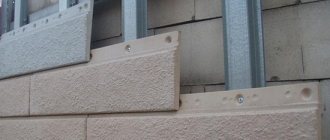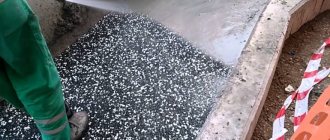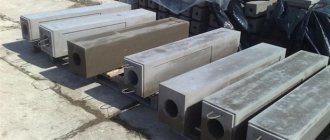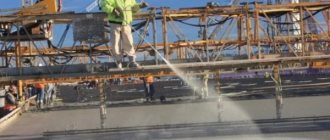Concrete is a solution that has found application in many construction processes, both on an industrial scale and during individual construction. A small volume of such a solution can be mixed manually, but to prepare large volumes of material you will certainly need a concrete mixer.
The variety of models and modifications of such units indicates their demand in the modern market. But, despite this popularity, many builders still ask questions about how to properly mix concrete in a concrete mixer?
Creating a solution
Concrete composition: what's included?
Making concrete in a concrete mixer is a simple process. It is only important to prepare the solution correctly, select high-quality starting materials, and strictly follow the procedure. For the foundation, as well as for the purpose of erecting a supporting structure, it is necessary to prepare a high-quality, durable and reliable solution. It will be possible to make concrete that meets the declared physical and technical characteristics using components such as:
- cement;
- sand;
- crushed stone or gravel;
- water.
To make the sand-cement mortar of better quality, it is recommended to additionally add plasticizers to it. The substance prevents rapid freezing of the mixture, otherwise it loses its declared qualities. In addition, plasticizers accelerate the hardening of the solution even in conditions of high humidity.
It is prohibited to add dishwashing detergent to the concrete mixture instead of plasticizers. This replacement will lead to the fact that such important indicators as density and strength will significantly decrease, and this will negatively affect the quality of concrete and, as a consequence, the reliability of the structure.
Preparing concrete in a concrete mixer
When dealing with a concrete mixer, you need to know the exact amount of each “ingredient” in order to prepare quality concrete. It should be noted that the solution can turn out to be of different consistency, because each specific case corresponds to its own number of added components. But all the materials that make up concrete are known: cement, sand, water, crushed rocks (crushed stone or gravel). Sometimes special impurities are added to the solution.
The grade of the finished mortar obtained as a result of mixing depends on the quality of the cement itself and its proportion relative to other components. Basically, the choice falls on cement “M400” and “M500”. For example, with a ratio of “four hundredth” cement, crushed stone, sand and water, like 2-8-4-1, “M250” concrete will be produced. The “M350” grade will be obtained using “five hundredth” cement.
A certificate of conformity is the main sign of good cement; keep this in mind when purchasing it.
Each concrete mixer has its own load limit for “ingredients”, which cannot be exceeded (the drum capacity of each device is indicated in the instructions). Be sure to load the components in strict sequence: add water, add cement, sand, and then rock material (crushed stone or gravel). Make sure that the consistency and color of the finished solution in the concrete mixer is uniform.
How to calculate proportions?
When making a solution in small quantities, you can use a bucket as a measuring container.
The main components of structural concrete are cement, water, sand and additional additives.
If it is necessary to obtain a solution with increased strength and reliability, use concrete made from ASG - a sand-gravel mixture. If you need to produce a relatively small volume of concrete, it is recommended to use a bucket as a measuring container. It is important to take into account here that all components of the solution with the same volume have different masses. The proportions of concrete in buckets are calculated in kilograms. The weight of cement, sand and crushed stone in one 10-liter bucket will be 15, 19 and 17.5 kg, respectively. The number of components is mixed depending on the required cubes. The optimal proportions C: P: SCH in 1 m³ of concrete dough are 2: 5: 9.
Features of working with a concrete mixer
The concrete mixer must be installed on a flat, horizontal surface. During the mixing process, you need to change the angle of the rotating drum. This increases the mixing intensity and promotes the formation of a homogeneous mixture. It is not recommended to mix the solution for a long time. The mixture loses moisture, and the concrete itself becomes thicker.
To check the readiness of the concrete mixture, a small amount is taken. Then, with a trowel or shovel, a ribbed surface is formed in the concrete. If the mixture holds its shape, your solution is ready. The material spreads, which means additional mixing is required.
How does a concrete mixer work?
Before you start working with a concrete mixer, it is first useful to familiarize yourself with what types there are. To prepare a high-quality solution, builders often use the following types of mixers:
- Gravitational. This is a rotary mixer with electric drive. Mixing a high-quality mixture is carried out using blades located inside, which capture the solution, lift it to the top of the container, and then, under the influence of gravity, the mass falls down.
- Forced. This device is more complex; it is a horizontal container, the inner part of which is equipped with a screw with blades. During the rotation of these elements, high-quality concrete is prepared in a concrete mixer.
- Vibrating. It looks like a vertical container, on top of which the main components of the solution are poured, and from below the finished product comes out. While the concrete mixer is mixing the solution, mechanical vibrators are placed inside the bunker, which contribute to better mixing of the mass.
Types of concrete mixers for preparing concrete mixture
Based on the principle of operation, there are two types of concrete mixers:
- Gravity concrete mixer
- mixes the solution using blades clearly attached to the drum itself. To change the intensity of rotation of the drum, you can constantly change the angle of its inclination. All elements of gravity concrete mixers are very quickly and simply separated, which makes it easy to transport. - Forced action concrete mixers
- the body of such devices is stationary. These concrete mixers are used to mix a very thick mixture with a small amount of water. Often used to produce pavement slabs. The process of mixing the solution is more thorough, resulting in high quality concrete. The price category is much higher than that of gravity devices, so buying units with forced action without a large scope of construction work is not a profitable solution.
Procedure before mixing
The concrete mixer should be located as close as possible to the construction site, which will reduce the time it takes to deliver the heavy mixture to the work site.
Before you start preparing the solution in a concrete mixer, it is recommended to study the rules of its operation. Here are the main ones:
- Workplace layout. At the exit, the finished concrete mass weighs a lot. Therefore, in order not to carry heavy loads over long distances and to reduce operating time, it is recommended to install the mixer as close as possible to the object under construction.
- Ensuring safe access to electricity. It is important not only to knead the solution correctly, but also safely. Therefore, all stirrer wires must be reliably insulated from damage and moisture. You can secure wiring on the floor using a metal corner that is placed on top of the wires.
- Preparation of a concrete unloading plan. Most often, they prefer to load the mass from a concrete mixer into a construction wheelbarrow, and from there deliver it directly to the site.
Proper care of the unit will ensure its long and reliable operation. Each time after mixing, it is necessary to clean the tank from concrete, lubricate the gears once a month, and inspect the mechanism for damage.
Mixing technology
Regardless of what type of concrete mixer you purchase, the mixing instructions remain the same, so in order to understand how to use a concrete mixer correctly, it is enough to become familiar with the same technology.
Basic Rules
First you need to understand and remember the basic rules:
- The solution components are loaded as their density decreases;
- Lastly, water is added;
- The mixing process is carried out until the mass acquires a uniform color and uniform consistency.
Kneading
The procedure for mixing the solution is carried out according to the following algorithm:
- Installation . The concrete mixer is placed on a fairly level surface in order to avoid excessive wear on the rotating structural elements.
Advice. If necessary, you can place wooden supports under the supporting parts of the device to ensure the stability of the unit.
- Preparation . In order to prevent the concrete mass from sticking to the walls and blades of the device, before starting work, it is necessary to lubricate it with a mass made from water, cement and fine filler, machine oil or technical grease;
- Loading . When loading solution components, you should rely on the nominal capacity of the mixer. Overload can lead to deterioration in the quality of the solution or failure of the concrete mixer;
Loading
Advice. In order to avoid overloads, many builders first fill in coarse aggregate and water, and only then sand and cement.
- Kneading . The mixing process takes about 1-2 minutes after you have added all the ingredients. It is also undesirable to increase the mixing time of the solution, since loss of plasticity of concrete is possible due to evaporation of the liquid;
Advice. While the drum is spinning, do not insert any objects into it or tilt it. It is necessary to work with gloves.
- Readiness control . In order to make sure the mixture is ready, you need to tilt the drum and move a small amount of it into a wheelbarrow or other container. The surface of the mass should be smooth. Using a shovel, you should make a series of ridges, and if they remain, then the solution is ready for further use;
Control ribs
- Unloading . The finished solution is unloaded into a container, after which it is moved onto a stretcher or into a wheelbarrow for further transportation. Thus, heavy fractions do not accumulate at the bottom, but are evenly distributed throughout the entire mass, which increases the strength of the final product;
Unloading solution
- Washing . After working with the solution is completed, the mixer container must be filled with water and rinsed well.
Kneading rules
Mixing the solution should not exceed ten minutes in time, as its qualities are lost.
The technology for preparing concrete in a concrete mixer is not complicated; it is important to first prepare the starting materials and study the instructions, thanks to which you will be able to correctly mix the high-quality mass. It is important to remember that the time for preparing the solution should not exceed 10 minutes, otherwise the concrete will begin to set and the solution will turn out to be of poor quality.
The stages of mixing concrete mortar are as follows:
- Connect the equipment to electricity.
- Pour most of the water into the mixer. If you decide to add fiber, you should add it at this stage. Turn on the mixer and mix both components at low speed.
- Add 1 part of the prepared crushed stone, scroll.
- All the cement is added little by little, mixed, and then the required amount of sand is laid.
- If reverse is provided in the concrete mixer mode, it is recommended to use it, but do so infrequently, otherwise the device will burn out from the load.
- According to the attached instructions, dissolve the plasticizing additive in water, then add it little by little to the mixture.
- Pour in the rest of the crushed stone and let the mixer thoroughly mix the entire composition.
The finished solution can be used further for construction purposes. It is important to remember that the fewer operations occur during unloading, the less concrete will be lost. When constructing a large structure, you cannot do without a concrete mixer, however, if you still cannot get one, you can order a ready-made solution for the site, having previously calculated the required volume. For small customers, for erecting a small building or pouring a foundation, it is recommended to order a KAMAZ mixer, the drum of which holds 6-10 m3. A cubic meter of concrete weighs on average 2.4 tons.
Delivery
Preparing the solution is the beginning of the work. It still needs to be delivered to the place of use. In domestic conditions, ordinary buckets are most often used for this purpose. It is not recommended to use galvanized ones: their handles quickly become unusable. Such buckets are very difficult to clean; the solution on their walls accumulates more and more each time. It is better to use polymer buckets. Containers from ready-made putty performed especially well. They can last for several years without losing their shape or breaking the handles. Their volume is usually 17 liters. They have a reliable and durable design, are made of high-quality material, the solution does not stick to them, they are easy to clean, and also have very comfortable metal handles.
Criteria for selecting concrete components
Water
In production processes, water is used to prepare the concrete mixture, the composition of which complies with GOST standards. If making your own, prepare drinking water.
Important! Check the quality of the water; it should be free of alkalis, sugar, oils, acids and other impurities.
Cement
The general name of a binder, the basis of which is marly, calcareous, and clayey rocks. Most often today, Portland cement is used in construction, with a high percentage of calcium silicates.
Cement classification:
- Without additives, that is, their content in the composition does not exceed 5%. Marking “TO” or “SEM I”.
- With additives, the percentage of which varies within 35. Marking D+ Indicator of the content of additives in percentage, for example, “D15” or “CEM II”.
When purchasing, pay attention to the following nuances:
- permissible period of use of the mixture
- storage conditions
- make sure the moisture level is correct, i.e. that the cement is not damp
- check the flowability of the substance (it should not be stale or compressed)
- Make sure each bag is properly marked
- the grade of cement should exceed the grade of the planned concrete (see below for more information) by 2-3 times.
Important! Do not buy cement too early, 1-2 weeks is enough. If storage conditions and conditions are not observed, it loses quality, which will affect the strength characteristics of concrete.
The choice of sand has its own conditions and requires the right approach.
Please note the following points:
- Granule size. There are several types, the size range of which varies from 1.2 to 3.5 mm. Give preference to coarse sand.
Important! Please note that the smaller the granules, the greater the sand consumption in the preparation of the concrete mixture and the lower the strength of the finished hardened composition.
- Purity of the substance. Use the cleanest possible material without impurities and dirt (plant particles, silt, clay, glass, soil, dust). Check for their presence by sifting or washing the sand.
Important! This criterion affects the degree of setting, the consumption of cement for preparing concrete and water.
- Flowability. The sand should be well dried, and not wet, since the recipes indicate the amount of dry matter.
Important! In any state of sand, a certain percentage of absorbed moisture is present in it, which is usually taken into account when compiling the proportions of substances. In dry conditions, this figure does not exceed 1%.
Crushed stone
Please pay attention to the following criteria:
Important! Please note that most often it is the quality of crushed stone that affects the strength of concrete.
Expanded clay
This material is not one of the main components of concrete, but to create a lightweight mortar (to reduce the load on the floors and structure frame), expanded clay is often used instead of crushed stone.
When choosing this material, pay attention to:
- fraction size - from 3 to 5 mm
- flowability of the substance
- purity and uniformity.
Mixing options and order
There are two sequences for loading into a concrete mixer, the first for the manual version, and the second for the industrial version. When loading manually, it will not be possible to make a lot of solution in one go, while ordering the industrial version is a little more expensive, but the result is also better.
Manual loading of a concrete mixer begins with mixing sand and gravel in a mixer bowl in a ratio of 1.5:1.5 or filling with 3 shares of ASG. Then the mixer is started and 1 share of cement is poured out, and it is advisable to leave the time for mixing them for 1 minute. And only at this stage can you begin to pour in water, and its amount varies from 0.8 to 1.2 parts, depending on the preparedness of the solution. The mixing time is 2-3 minutes, after which you can stop the mixer and remove the resulting mixture from it.
If it is not concrete that is being prepared, but cement, then the ratio of sand, cement and water will be 2:1:0.8.
But the industrial version is much more complicated, because... requires more precision:
- Sand and gravel are mixed in a ratio of 1:1.5, resulting in maximum quality. If cement is prepared, then 1.4 parts of sand are used.
- ASG and cement are mixed, but the process still occurs in separate dry containers.
- 70% of water is poured into the automixer.
- The dry mixture is poured out as quickly as possible, after which the rotation of the concrete mixer starts.
- After 1 minute, the remaining amount of water is added, and you need to watch carefully, because The planned volume is not always needed.
If you break the sequence, you may end up with a solution with lumps or insufficient quality. It is worth remembering that with prolonged stirring the solution will gain strength, but this lasts 23-30 minutes, after which the effect sharply reverses, so it is better not to risk it.
Sometimes misunderstandings occur when the order of loading a concrete mixer is violated for some reason, and this can be noticed after the mixer is started, which is not fatal. If the solution turns out to be too thin, then you need to add 10% coarse sand or 5% cement, depending on the circumstances, while if it is too thick, add 5-10% water.
It is worth remembering that even in those places where high quality results are not required (M100 is enough), it is better to overpay a little, but make the most durable design possible.
It is thanks to the high grade and durable construction that the foundations can withstand the pressure of heaving soils, seasonal frosts, flooding and other adversities.
When performing construction and repair work, it is often necessary to prepare a solution. To facilitate this operation, concrete mixers are used. The principle of operation of a concrete mixer is simple: a certain amount of water is poured into the device, sand, cement, gravel or other fillers are poured. When the unit is turned on, the blades inside the drum thoroughly mix all the components to a completely homogeneous mass within a few minutes. All that remains is to deliver the solution to the place of its use.
Using a concrete mixer greatly simplifies the preparation process.
To prepare the solution, concrete mixers of the gravity type and the forced operating principle are used.
A special feature of a gravity-type concrete mixer is a movable drum with special blades on the walls.
In the first case, the mixture is mixed inside a rotating drum using blades. Such units are easy to transport; they are easy to assemble and disassemble in a few minutes. The cost of installation varies from 4,500 rubles and above.
The forced action mixer has a stationary drum. Rotating blades inside the drum mix the ingredients. Such installations work more efficiently than gravity ones. With their help, you can prepare a thick and dense solution with a minimum amount of liquid. But they also cost 10 times more. It makes sense to purchase such units for your own use if you need to perform large volumes of work using a solution. For example, for making concrete paving slabs at home.
The main advantage of forced-action concrete mixers is the high quality of mixing the mixture.
Working with a concrete mixer of any type allows you to prepare a solution for the construction of brick and block walls, for plastering and concrete screeding of various surfaces.
Construction stores sell a large selection of concrete mixers for private use. All of them are gravitational type. They are driven by a gear ring from an electric motor or a belt drive. Motor power consumption is about 700 W. This is 3 times less than the power of an electric kettle. Drum capacity is about 160 liters. This is enough to prepare 100 liters. There are mixers with a drum capacity from 60 to 240 liters.
Other options
If you understand that you will not be able to prepare the foundation for pouring the foundation of a frame house or other small structures with your own hands, then seek the help of professionals.
Without racking your brains over how many components to take and how to mix them, you can buy a cube of concrete, which should be enough for a small construction project.
A cube of this construction product costs from 2,400 rubles. This figure applies to the lowest grade. A medium-strength cube (M400) costs from 3,200 rubles. The most expensive and reliable brand is M600.
A cube of such concrete will cost 4 thousand.
During any construction work, it is necessary to adhere to a certain procedure in order for the result to be of the highest quality. The exact order in which the concrete mixer is loaded is one of the most important factors on which the final quality of the solution depends.
A concrete mixer is a construction equipment designed to prepare a homogeneous concrete mixture.
How to choose the right brand of concrete?
To make the right brand of concrete, you should take into account its purpose.
With low strength
(M100, M150) are used for roads or floor screeds, also used in production for light loads.
Medium brands
(M200, M250) – for creating foundations in one-story buildings, as well as platforms and stairs.
High strength
(M350) – for creating complex structures that are subject to heavy loads. Used in industrial enterprises. M400 concrete is used for the construction of bridges.
Concrete marking
Concrete is classified according to:
- class (B)
- mark (M).
The grade of concrete indicates the compressive strength and load capacity. Indicators vary from 50 to 1000 kgf/cm2. That is, for example, M300 concrete can withstand up to 300 kg/cm2. The class of the mortar indicates guaranteed strength in 95 cases out of 100. The range of indicators is from 3.5 to 80.
Plan the specific type of mixture based on the purpose.
The table below shows acceptable grades and classes of concrete with strength indicators.
Operating principle and advantages
I think you already understand how concrete mixers work and how to mix concrete in them. Let's summarize:
- in some, only the blades rotate, and the drum itself is motionless (forced type of machines);
- and for others, the drum itself rotates on which the blades are mounted (these are gravitational mixers).
Next I will describe the advantages of each type of mixers. For convenience, we will make a table.
| Type of concrete mixer | Advantages |
| Gravitational |
|
| Forced |
|
The choice is yours. A properly selected unit will make work easier and allow you to make high-quality concrete. If the amount of work is small and there is no need to mix different reinforcing fibers, fine-grained components and pigments, a gravity machine will do. Yes, its disadvantage is that it does not mix small elements very well.
Classification and table of concrete density
If there is a question of quality and you need to mix a lot of cement, think about a forced aggregate. In this case, a machine with a vertical shaft is recommended; it has fewer problems with unloading the solution.
Conditions for cooking
When preparing concrete yourself, be sure to observe not only the technical aspects of the process, but also the conditions under which the solution is produced:
- air temperature 15-20
- Humidity level within 90%.
Important! If you are pouring in conditions of severe aridity or low temperatures, use special additives that regulate the hardening process, thermal insulation materials and additional irrigation.











